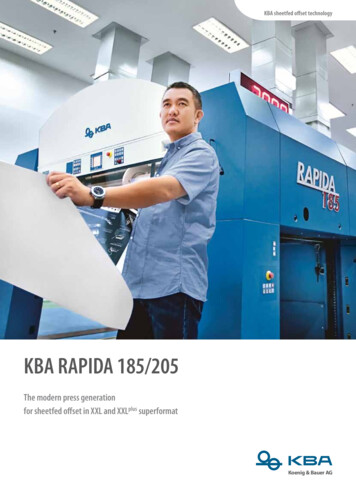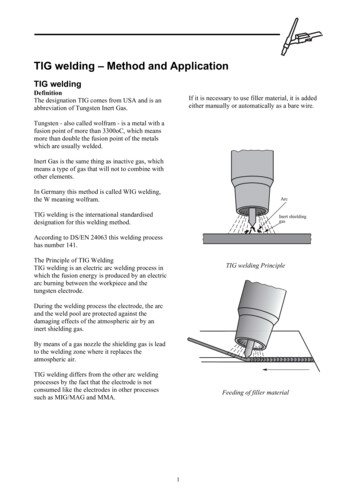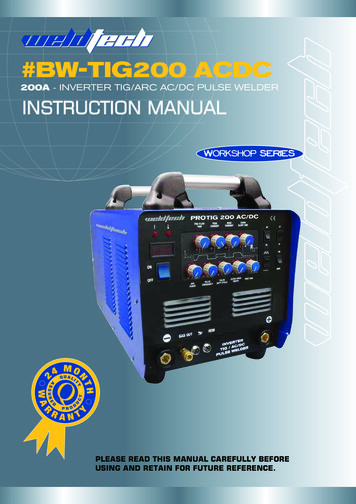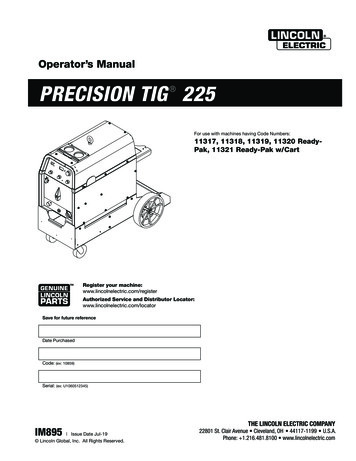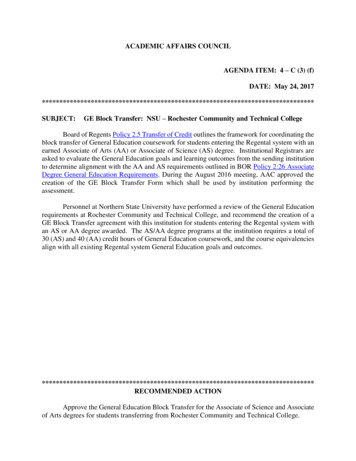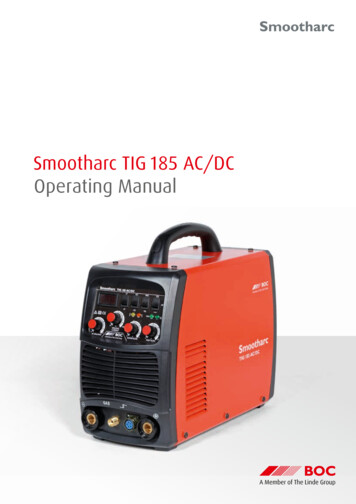
Transcription
Smootharc TIG 185 AC/DCOperating Manual
2BOC Smootharc TIG 185 AC/DC Operating ManualWelcome to a better way of welding.This operating manual provides the basic knowledge required for TIGwelding, as well as highlighting important areas of how to operate theSmootharc TIG 185 AC/DC machine.With normal use and by following these recommended steps, yourSmootharc TIG 185 AC/DC machine can provide you with years oftrouble free service. BOC equipment and technical support is availablethrough our national BOC Customer Service Centre or contact your localGas & Gear outlet.Important NoticeThis document has been prepared by BOC Limited ABN 95 000 029 729 (‘BOC’), as general information and does not contain and is not to be taken as containing any specific recommendation. The document has been prepared in good faithand is professional opinion only. Information in this document has been derived from third parties, and though BOC believes it to be reliable as at the time of printing, BOC makes no representation or warranty as to the accuracy, reliability orcompleteness of information in this document and does not assume any responsibility for updating any information or correcting any error or omission which may become apparent after the document has been issued. Neither BOC nor any ofits agents has independently verified the accuracy of the information contained in this document. The information in this document is commercial in confidence and is not to be reproduced. The recipient acknowledges and agrees that it mustmake its own independent investigation and should consider seeking appropriate professional recommendation in reviewing and evaluating the information. This document does not take into account the particular circumstances of the recipientand the recipient should not rely on this document in making any decisions, including but not limited to business, safety or other operations decisions. Except insofar as liability under any statute cannot be excluded, BOC and its affiliates,directors, employees, contractors and consultants do not accept any liability (whether arising in contract, tort or otherwise) for any error or omission in this document or for any resulting loss or damage (whether direct, indirect, consequentialor otherwise) suffered by the recipient of this document or any other person relying on the information contained herein. The recipient agrees that it shall not seek to sue or hold BOC or their respective agents liable in any such respect for theprovision of this document or any other information.
3BOC Smootharc TIG 185 AC/DC Operating ManualContents.1.0 Recommended safety guidelines and precautions41.11.21.31.45577Health hazard informationPersonal protectionElectrical shockUser responsibility2.0 Gas tungsten arc welding (GTAW/TIG)82.1 Introduction2.2 Process2.3 Process variables2.4 Shielding gas selection2.5 Welding wire selection2.6 Non consumable tungstens2.7 Welding techniques2.8 Torch movement during welding2.9 Positioning torch tungsten for various weld joints2.10 Joint preparation889101011121214153.0 TIG welding of ication summaryC-Mn steelAlloyed steelStainless steelAluminiumBalanced squarewaveCopper and copper alloys4.0 Package contents215.0 Smootharc TIG 185 AC/DC installation225.1 Installation for TIG setup5.2 Installation for TIG setup with optional foot control5.3 Installation for MMA process2222236.0 Control panel246.16.26.3Function switchesAdjustment knobsIndicator function2424247.0Smootharc TIG 185 AC/DC operation257.17.27.37.4Operation for AC weldingOperation for DC weldingOperation for foot control (TIG welding only)Operation for MMA welding252525258.0 Troubleshooting and fault finding269.0 Periodic maintenance289.128Power source10.0 Technical specifications2911.0 Warranty information3011.111.211.311.430303030Terms of warrantyLimitations on warrantyWarranty periodWarranty repairs
4BOC Smootharc TIG 185 AC/DC Operating Manual1.0 Recommended safety guidelinesand precautionsDiagram and safety explanationElectrical safety alertWelding electrode causing electric shockFumes and gases coming from welding processWelding arc raysSome safety precautions BOCrecommends are as follows: Repair or replace defective cables immediately.Read instruction manual Never watch the arc except throughlenses of the correct shade. In confined spaces, adequate ventilationand constant observation are essential.Become trainedWear dry, insulated gloves Leads and cables should be kept clearof passageways. Keep fire extinguishing equipment at a handy locationin the workshop. Keep primary terminals and live parts effectively covered.Insulate yourself from work and ground Never strike an arc on any gas cylinder. Never use oxygen for venting containers.Disconnect input power before working on equipmentKeep head out of fumesUse forced ventilation or local exhaust to remove fumesUse welding helmet with correct shade of filter
BOC Smootharc TIG 185 AC/DC Operating Manual1.1Health hazard informationThe actual process of welding is one that can cause a variety of hazards.All appropriate safety equipment should be worn at all times, i.e.headwear, hand and body protection. Electrical equipment should beused in accordance with the manufacturer’s recommendations.EyesThe process produces ultra violet rays that can injure and causepermanent damage. Fumes can cause irritation.SkinArc rays are dangerous to uncovered skin.InhalationWelding fumes and gases are dangerous to the health of the operatorand to those in close proximity. The aggravation of pre-existingrespiratory or allergic conditions may occur in some workers. Excessiveexposure may cause conditions such as nausea, dizziness, dryness andirritation of eyes, nose and throat.1.2Personal protectionRespiratoryConfined space welding should be carried out with the aid of a fumerespirator or air supplied respirator as per AS/NZS 1715 and AS/NZS 1716Standards. You must always have enough ventilation in confined spaces. Be alertto this at all times. Keep your head out of the fumes rising from the arc. Fumes from the welding of some metals could have an adverse effecton your health. Don’t breathe them in. If you are welding on materialsuch as stainless steel, nickel, nickel alloys or galvanised steel, furtherprecautions are necessary. Wear a respirator when natural or forced ventilation is insufficient.Eye protectionA welding helmet with the appropriate welding filter lens for theoperation must be worn at all times in the work environment. Thewelding arc and the reflecting arc flash gives out ultraviolet and infraredrays. Protective welding screen and goggles should be provided forothers working in the same area.Recommended filter shades for arc weldingLess than 150 amps150 to 250 amps250 to 300 amps300 to 350 ampsOver 350 ampsShade 10*Shade 11*Shade 12Shade 13Shade 14*Use one shade darker for aluminium.ClothingSuitable clothing must be worn to prevent excessive exposure to UVradiation and sparks. An adjustable helmet, flameproof loose-fittingcotton clothing buttoned to the neck, protective leather gloves, spats,apron and steel capped safety boots are highly recommended.5
6BOC Smootharc TIG 185 AC/DC Operating Manual123Back view of typical cylinder valve.Operator wearing personalprotective equipment (PPE)in safe position.Cylinder safety diagram123Cylinder valve hand-wheelBack-plugBursting discTen points about cylinder safety12345678910Read labels and Material Safety Data Sheet (MSDS) before useStore upright and use in well ventilated, secure areas away frompedestrian or vehicle thoroughfareGuard cylinders against being knocked violently or being allowedto fallWear safety shoes, glasses and gloves when handling andconnecting cylindersAlways move cylinders securely with an appropriate trolley. Takecare not to turn the valve on when moving a cylinderKeep in a cool, well ventilated area, away from heat sources,sources of ignition and combustible materials, especiallyflammable gasesKeep full and empty cylinders separateKeep ammonia-based leak detection solutions, oil and greaseaway from cylinders and valvesNever use force when opening or closing valvesDon’t repaint or disguise markings and damage. If damaged,return cylinders to BOC immediatelyCylinder valve safetyWhen working with cylinders or operating cylinder valves, ensurethat you wear appropriate protective clothing – gloves, boots andsafety glasses.When moving cylinders, ensure that the valve is not accidentally openedin transit.Before operating a cylinder valveEnsure that the system you are connecting the cylinder into is suitable forthe gas and pressure involved.Ensure that any accessories (such as hoses attached to the cylinder valve,or the system being connected to) are securely connected. A hose, forexample, can potentially flail around dangerously if it is accidentallypressurised when not restrained at both ends.Stand to the side of the cylinder so that neither you nor anyone else isin line with the back of the cylinder valve. This is in case a back-plugis loose or a bursting disc vents. The correct stance is shown in thediagram above.When operating the cylinder valveOpen it by hand by turning the valve hand-wheel anti-clockwise. Useonly reasonable force.Ensure that no gas is leaking from the cylinder valve connection orthe system to which the cylinder is connected. DO NOT use ammoniabased leak detection fluid as this can damage the valve. Approved leakdetection fluid, can be obtained from a BOC Gas & Gear centre.When finished with the cylinder, close the cylinder valve by handby turning the valve hand-wheel in a clockwise direction. Use onlyreasonable force.Remember NEVER tamper with the valve.If you suspect the valve is damaged, DO NOT use it. Report the issue toBOC and arrange for the cylinder to be returned to BOC.
BOC Smootharc TIG 185 AC/DC Operating Manual1.3Electrical shock Never touch ‘live’ electrical partsBOC stock a huge range of personal protective equipment. This combinedwith BOC’s extensive Gas and Gear network ensures fast, reliable servicethroughout the South Pacific. Always repair or replace worn or damaged parts Disconnect power source before performing any maintenance or service Earth all work materials Never work in moist or damp areasAvoid electric shock by: Wearing dry insulated boots Wearing dry leather gloves Never changing electrodes with bare hands or wet gloves Never cooling electrode holders in water Working on a dry insulated floor where possible Never hold the electrode and holder under your arm1.4User responsibility Read the Operating Manual prior to installation of this machine Unauthorised repairs or modifications to this equipment may endangerthe technician and operator and will void your warranty. Only qualifiedpersonnel approved by BOC should perform repairs Always disconnect mains power before investigating equipmentmalfunctions Parts that are broken, damaged, missing or worn should be replacedimmediately Equipment should be cleaned periodically7STOPPLEASE NOTE that under no circumstances should anyequipment or parts be altered or changed in any way from thestandard specification without written permission given byBOC. To do so, will void the Equipment Warranty.Further information can be obtained from Welding Institute of Australia(WTIA) Technical Note No.7.Health and Safety WeldingPublished by WTIA,PO Box 6165 Silverwater NSW 2128Phone (02) 9748 4443
8BOC Smootharc TIG 185 AC/DC Operating Manual2.0 Gas tungsten arc welding (GTAW/TIG)Schematic of the TIG welding processColletShielding gasTungsten electrodeArcTIG filler rodWeld pool2.1WorkpieceIntroductionThe Tungsten Inert Gas, or TIG process, uses the heat generated by anelectric arc struck between a non-consumable tungsten electrode andthe workpiece to fuse metal in the joint area and produce a molten weldpool. The arc area is shrouded in an inert or reducing gas shield to protectthe weld pool and the non-consumable electrode. The process may beoperated autogenously, that is, without filler, or filler may be added byfeeding a consumable wire or rod into the established weld pool.2.2ProcessDirect or alternating current power sources with constant current outputcharacteristics are normally employed to supply the welding current.For DC operation the tungsten may be connected to either outputterminal, but is most often connected to the negative pole. The outputcharacteristics of the power source can have an effect on the quality ofthe welds produced.Shielding gas is directed into the arc area by the welding torch and agas lens within the torch distributes the shielding gas evenly over theweld area. In the torch the welding current is transferred to the tungstenelectrode from the copper conductor. The arc is then initiated by one ofseveral methods between the tungsten and the workpiece.
BOC Smootharc TIG 185 AC/DC Operating Manual2.3Process variablesProcess variableExplanationUsageDCENNarrow bead,deep penetrationNozzleIonsElectronsWhen direct-current electrode-negative (straight polarity) For a given diameter of tungsten electrode, higheris used:amperage can be used with straight polarity. Straightpolarity is used mainly for welding: Electrons strike the part being welded at a high speed Intense heat on the base metal is produced Carbon steels The base metal melts very quickly Stainless steels Ions from the inert gas are directed towards the Copper alloysnegative electrode at a relatively slow rateThe increased amperage provides: Direct current with straight polarity does not require Deeper penetrationpost-weld cleaning to remove metal oxides Increased welding speed A narrower, deeper, weld beadDCEPWide bead,shallow penetrationNozzleIonsElectronsThe DCEP (reverse polarity) are different from the DCEN in Intense heat means a larger diameter of electrode mustfollowing ways:be used with DCEP Maximum welding amperage should be rel
trouble free service. BOC equipment and technical support is available through our national BOC Customer Service Centre or contact your local Gas & Gear outlet. Important Notice This document has been prepared by BOC Limited ABN 95 000 029 729 (‘BOC’), as general information and does not contain and is not to be taken as containing any specific recommendation. The document has been .
